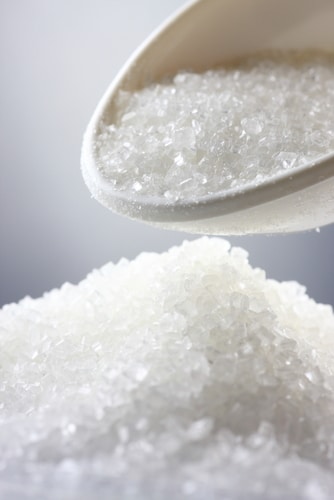
Salad Dressings
That bottle of low-fat French dressing may look pretty innocent until you look on the label and see it contains 7 grams of sugar. When manufacturers reduce the fat in salad dressings, they often add sugar to increase taste appeal. Look for a dressing that has 2 grams of sugar or less. Even better make your own at home using olive oil and balsamic vinegar.
Canned Soup and Vegetables
That bowl of canned soup you’re dipping your spoon into may have several teaspoons of added sugar. Even some canned vegetables have sugar added to increase their shelf life. Read the label carefully or choose fresh or frozen vegetables instead.
Protein Bars
When you bite into a protein bar, you’re getting more than a dose of muscle-building protein – you’re also getting added sugar. Why munch on protein bars when you can get protein from other sources like lean meat, eggs, milk, nuts, and beans? If you eat them out of convenience, read the label carefully. Some protein bars have as much as 20 grams of added sugar.
Fruit Juice
Fruit is loaded with vitamins, minerals, and antioxidants, but it’s best to enjoy it whole where you can benefit from the fiber and avoid sugar shock. Even fruit juice with no added sugar has concentrated amounts of natural sugar in the form of fructose, and they’re usually still high in calories. Sip water flavored with a squirt of lime or lemon juice or unsweetened iced tea instead, and enjoy your fruit as whole food.
Condiments
Condiments are another “hidden” source of sugar. Two tablespoons of ketchup have 8 grams of sugar, and most people don’t stop at a single serving. Other condiments that are deceptively high in sugar are teriyaki sauce, barbeque sauce, and cocktail sauce. Fortunately, Heinz makes ketchup that’s low in sugar – or just stick with mustard instead.
Flavored Yogurt
Yogurt is a food with a health halo. It’s a good source of gut-friendly bacteria called probiotics and an excellent source of calcium. On the other hand, if you buy flavored yogurt, you could be in for a sugar rush. Some flavored yogurts are loaded with as much as 40 grams of sugar and contain more than 200 calories per serving. Look for plain Greek yogurt, and flavor it yourself by adding fresh fruit.
Cereal
Some packaged cereals are more like dessert. Even those little packages of instant oatmeal that are so convenient to make, contain as much as 20 grams of added sugar – and you thought you were eating something healthy. Choose a cereal that’s high in fiber and contains less than 5 grams of sugar per serving or cook old-fashioned oatmeal in a slow cooker, and sweeten it with fruit.
Bread
Even the bread that holds your turkey sandwich together may have added sugar. Manufacturers often add sugar for additional flavor and to help the bread rise properly. Look for sugar-free bread that’s high in fiber and one that lists whole-wheat as the first ingredient.
The Bottom Line?
Watch out for these hidden sources of sugar. You may be getting more sugar in your diet than you think.
References:
Nutrition Data at Self.com
Related Articles By Cathe:
How Many Doughnuts Are Hidden in Your Diet: A Sugar Analysis of “Healthy” Foods
Sugar and Nutrition Labels: How They May Change
Health Risks of Sugar: Is It More Toxic Than You Think?
6 Tips for Making Healthier Choices at the Grocery Store
Should You Be Concerned about the Sugar in Fruit?
5 of the Worst Ingredients in Processed Foods

